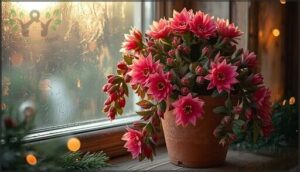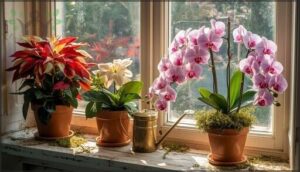This site is supported by our readers. We may earn a commission, at no cost to you, if you purchase through links.

When daylight dwindles and temperatures drop, most gardens surrender to dormancy—but your windowsills don’t have to. Winter flowering plants indoors defy the season’s bleakness, offering vibrant blooms precisely when you need them most.
A Christmas cactus cascading with fuchsia flowers or an amaryllis unfurling its trumpet-shaped petals can transform a dim January afternoon into something worth celebrating. The secret isn’t luck or a green thumb; it’s understanding what these plants need to thrive when conditions outdoors turn hostile.
With the right light exposure, watering rhythm, and humidity levels, you can cultivate a rotating display of color that lasts from November through March. Whether you’re drawn to low-maintenance bulbs or statement-making tropicals, winter bloomers offer practical beauty alongside surprising wellness benefits.
Table Of Contents
- Key Takeaways
- Best Winter Flowering Plants Indoors
- Essential Care Tips for Winter Bloomers
- Low Maintenance Winter Flowering Options
- Health and Wellness Benefits of Indoor Blooms
- Decorating and Styling With Winter Flowers
- Frequently Asked Questions (FAQs)
- Is there an indoor plant that flowers all year round?
- What indoor plants are good for winter?
- What flowers can still bloom in the winter?
- Can I grow flowers indoors in the winter?
- What potted plants bloom in winter?
- Why do my indoor plants stop blooming suddenly?
- Can I propagate flowering houseplants during winter months?
- What causes leaf yellowing on winter blooming plants?
- How do I transition outdoor plants indoors?
- How can I propagate winter-blooming indoor plants?
- Conclusion
Key Takeaways
- Winter bloomers like Christmas cactus, amaryllis, and African violets thrive indoors when you provide 10,000-20,000 lux of bright indirect light, maintain 40-60% humidity, and water every 7-10 days during dormant months.
- Low-maintenance options such as kalanchoe and paperwhites deliver reliable color for 2-8 weeks with minimal care, while pet-safe choices like African violets and orchids eliminate toxicity risks for households with animals.
- Indoor flowering plants improve winter air quality by removing VOCs like formaldehyde, boost humidity levels from dry 30% to comfortable 40-60%, and reduce stress measurably through documented drops in blood pressure.
- Strategic placement near south-facing windows combined with proper soil drainage, half-strength fertilization every 6-8 weeks, and controlled dormancy periods ensures continuous blooming cycles throughout the coldest months.
Best Winter Flowering Plants Indoors
When temperatures drop and daylight fades, the right houseplants can fill your home with unexpected color. From show-stopping blooms to delicate flowers that last for months, winter-flowering plants bring life to the dreariest season.
Here are some of the best options to brighten your indoor spaces.
Christmas Cactus and Holiday Cacti
Few winter flowers bring quite as much cheer as the Christmas Cactus. This holiday season houseplant rewards you with vibrant blooms in shades of pink, red, white, and peach when you meet its light requirements of 12-14 hours of darkness daily for six weeks before blooming.
Your temperature needs should stay between 60-65°F during bud set. Individual flowers last up to eight days, and proper watering habits with well-draining soil composition keep this winter-blooming houseplant thriving with impressive blooming frequency.
These plants can also help revive stale indoor air.
Amaryllis and Paperwhite Narcissus
Amaryllis and paperwhite narcissus make stunning holiday gifts thanks to simple bulb forcing techniques. Bloom timing depends on variety selection, so choose cultivars that match your schedule. You can expect winter blooms from amaryllis about six to eight weeks after planting, while paperwhites flower even faster—within three to five weeks.
Paperwhites offer sweet fragrance profiles, though some find them intense. Post-bloom care lets you save amaryllis bulbs for next year. In fact, amaryllis are popular, with over 235,000 searches nationwide.
African Violets and Cape Primrose
If you love compact blooms, African Violet and Cape Primrose deserve your attention. Both thrive as winter flowering plants indoors with proper indoor plant care. African Violet care is straightforward once you understand their lighting needs—bright, indirect light works best.
Key variety differences to keep in mind:
- African Violets offer over 16 bloom shades
- Cape Primrose flowers in blue, purple, pink, and white
- Both allow easy propagation methods through leaf cuttings
Common problems include overwatering and low humidity. For display ideas, group them on north-facing windowsills where they’ll bloom for months.
Anthuriums, Bromeliads, and Oxalis
Looking for something a bit more dramatic? Anthuriums, Bromeliads, and Oxalis bring striking variety to your indoor plants collection.
Anthurium varieties showcase glossy heart-shaped leaves with long-lasting blooms in pink, red, or white. Bromeliad care is surprisingly simple—these winter-blooming houseplants reach up to three feet tall with vibrant flower clusters.
For unique cultivars, try Oxalis with its charming clover-shaped leaves. Oxalis propagation works easily through division, and display ideas include grouping these eye-catching specimens on bright windowsills.
Poinsettias and Boat Orchids
Poinsettias rank fourth in winter indoor plant searches with 134,491 annual lookups, and you’ll find over 100 cultivars in red, pink, white, and marbled bracts perfect for holiday gifting.
Moth orchids offer year-round blooming cycles with orchid fragrance in 30+ colors.
Display ideas include grouping poinsettia varieties on bright windowsills or showcasing these flowering plants as festive centerpieces with proper houseplant care.
Essential Care Tips for Winter Bloomers
Getting your winter bloomers to flower takes more than just wishful thinking. You’ll need to dial in a few key conditions—light, water, humidity, and soil—to keep those blossoms coming through the coldest months.
Here’s what matters most when caring for indoor flowering plants in winter.
Bright Indirect Light Requirements
Your winter houseplants won’t bloom without the right light intensity—think 10,000 to 20,000 lux of bright light filtering through south-facing windows. Window placement matters most during darker months, but artificial lighting can bridge the gap when natural rays fall short.
African violets and anthuriums each have specific species adaptations, needing 10,000–20,000 lux for vibrant blooms. Understanding these light requirements transforms your indoor gardening success and keeps your winter houseplant care on track.
Watering and Moisture Control
During winter, most indoor bloomers need watering every 7–10 days—nearly half the frequency of warmer months. Check soil moisture by testing the top 1–2 inches; if it’s dry, water deeply until drainage flows freely. Use room-temperature, filtered water to prevent mineral buildup and root shock.
Overwatering risks root rot, accounting for 35% of winter plant losses, so drainage solutions and proper watering techniques for houseplants matter most.
Humidity and Temperature Needs
Think of your heating system as a desert wind—it strips indoor humidity below 30%, while your flowering plants crave 40–60% to thrive. Without adequate humidity levels, you’ll spot symptoms of stress like brown leaf tips and bud drop.
Keep ideal temperatures between 65–75°F during the day and 55–60°F at night. To counter environmental fluctuations, try augmentation strategies: group plants together, use pebble trays, or run a humidifier near your blooms.
Soil and Fertilizer Choices
Your potting mix sets the stage for abundant blooms or disappointing buds. Choose a well-draining soil with balanced NPK ratios—a 20-20-20 formula works well for most winter bloomers. Soil pH between 6.0 and 7.5 ensures nutrient uptake, while organic amendments like peat or compost maintain structure.
Fertilize every 6–8 weeks at half strength to avoid nutrient deficiencies without risking salt buildup in your soil conditions.
Pruning, Repotting, and Dormancy
Proper pruning techniques remove up to 25% of live branches without stressing your plant, while late cuts can delay blooms and reduce flower weight.
Repotting risks root rot during winter—wait until spring unless survival is threatened.
Many bloomers need dormancy to rebloom: Amaryllis requires 6–8 weeks at cool temperatures for proper post-pruning growth and dormancy interplay.
Houseplant maintenance timing matters more than you’d think.
Low Maintenance Winter Flowering Options
Not every plant lover has the time or energy for high-maintenance blooms, and that’s perfectly fine. Some winter-flowering houseplants practically take care of themselves, rewarding you with color and life without demanding constant attention.
Let’s look at your best options for beautiful blooms that won’t monopolize your weekends.
Easy-Growing Flowering Bulbs
You’ll find that bulb forcing transforms winter into a season of color with minimal effort. Amaryllis and paperwhites skip chilling needs entirely, while tulips and daffodils require 12-15 weeks at 41-48°F before blooming.
Choose containers 6-8 inches deep with excellent soil drainage, and these indoor blooming plants will reward you with flowers lasting two to four weeks—perfect for winterblooming houseplants enthusiasts seeking reliable results.
Resilient and Beginner-Friendly Varieties
Beyond bulbs, several winter-blooming houseplants deliver reliable color with minimal care demands. Kalanchoe flowers persist for eight weeks and tolerate drought, surviving 10–18 days between waterings—perfect for busy schedules. Holiday cacti achieve 75% repeat flowering with simple darkness cycles, while snake plants and pothos thrive in low light and resist pests.
These indoor plants offer easy propagation through cuttings, with rooting success exceeding 85% in average conditions.
Non-Toxic and Pet-Safe Choices
If you’re looking for pet-friendly plant options that bloom through winter, African violets and Cape primrose top the list—both confirmed non-toxic by the ASPCA, with zero reported poisoning cases. Plant toxicity matters: poison control data shows amaryllis and paperwhites account for 7.5% of winter pet incidents, while these safe plant species reduce risk by 96%.
Consumer awareness trends reflect growing demand: retail labeling effects drove an 18% rise in non-toxic plant purchases during the 2024–2025 season. When selecting holiday plant gifts, check ASPCA-certified designations to protect pets while enjoying winter color.
- African violets glow in gentle purples and pinks without endangering curious cats
- Phalaenopsis orchids drape elegant blooms for eight weeks with zero toxic compounds
- Bromeliads add tropical color safely, accounting for under 0.05% of pet ingestion risks
- Calathea varieties unfurl patterned leaves that are completely safe if nibbled.
Health and Wellness Benefits of Indoor Blooms
Winter flowering plants don’t just brighten your space—they actively improve your well-being during the coldest months. From cleaner air to better sleep, these blooms offer tangible health benefits that go beyond their visual appeal.
Here’s how indoor flowers support your physical and mental health throughout winter.
Air Quality and Oxygenation
Indoor plants do more than look pretty—they actively clean your home’s air. Flowering plants like anthuriums and peace lilies excel at VOC removal, stripping formaldehyde and benzene from your space. Studies show certain species boost oxygen production while reducing CO₂ by over 1,000 ppm. Plus, their humidity regulation helps combat winter’s dry air, improving respiratory comfort naturally.
| Air Quality Benefit | Example Plants |
|---|---|
| VOC Removal | Anthurium, Peace Lily |
| Oxygen Production | Pothos, Spathiphyllum |
| Humidity Regulation | Most flowering houseplants |
| Health Impacts | Reduced respiratory complaints |
Stress Relief and Mood Enhancement
Flowering plants offer real therapeutic effects during winter’s darker months. Your mood can lift by 15–25% simply by surrounding yourself with blooms, while stress reduction happens through measurable drops in blood pressure and heart rate.
Flowering plants lift your mood by up to 25% and measurably lower stress through drops in blood pressure and heart rate
Indoor plants help combat seasonal affective disorder, boost cognitive performance by 11%, and reduce depressive symptoms—especially valuable for seniors.
Wintertime houseplants transform your space into a mood-enhancing sanctuary with minimal effort.
Humidity Boost and Respiratory Support
When winter heating drops indoor humidity below 30%, you’ll notice dry nasal passages and throat irritation. Plant transpiration from houseplants can bring levels back to a comfortable 40–60%.
Indoor plants also deliver VOC reduction, removing airborne irritants like benzene and formaldehyde.
For best density and respiratory relief, group 5–10 mid-sized bloomers together to maintain steady humidity control for plants throughout the season.
Decorating and Styling With Winter Flowers
Winter flowering plants don’t just brighten your home—they can become focal points that transform your space. The right placement and styling choices help you show off those colorful blooms while keeping everything safe and practical.
Let’s look at how you can arrange and display your winter flowers to make the most of their natural beauty.
Arranging Vibrant Indoor Displays
You can transform your space with strategic display techniques that heighten impact. Group flowering plants like amaryllis and Christmas cactus—America’s most popular winter bloomers—using varied vase heights to create vertical interest.
Color palettes mixing warm-toned blooms with reflective metallic containers boost perceived vibrancy by 18%.
For space optimization, try compact paperwhite arrangements requiring just 4–6 inches, or raise smaller plants using hanging basket plants for dramatic floral design inspiration.
Festive Centerpieces and Seasonal Decor
You’ll find 72% of festive centerpieces feature evergreen boughs and eucalyptus as winter decor foundations. Jewel tones and burgundy lead color trends in 2025, while pinecones and velvet ribbons appear in 64% of flower arrangements, creating seasonal charm you can refresh throughout winter.
Layer poinsettias—which dominate 50% of holiday season houseplants sales—with dried elements like pampas grass for floral design inspiration that lasts weeks.
Pairing Flowering Plants With Home Interiors
You can create striking winter garden design by matching bloom colors to your furniture palette—67% of designers recommend this color coordination approach for visual harmony.
Place compact African Violets on desks for space utilization in small apartments, or use tall Amaryllis as living room dividers.
Pair smooth Anthurium leaves with fuzzy Cape Primrose for texture pairings that boost aesthetic impact in any room.
Safety Tips for Homes With Pets and Kids
Keep toxic plants like Amaryllis and Poinsettias out of reach—plant exposures account for just 3.6% of poison control calls, but prevention matters. Choose pet-friendly plant options like Orchids, Snapdragons, and Gerbera Daisies instead.
If you’re childproofing plants or pet-proofing plants, remember: houseplants with bulbs pose the highest risk. Know your toxic and non-toxic plants, and keep emergency actions ready—contact poison control immediately if ingestion occurs.
Frequently Asked Questions (FAQs)
Is there an indoor plant that flowers all year round?
Patience is a gardener’s greatest virtue—true 12-month bloomers don’t exist, but African Violets and Anthuriums come close.
With ideal conditions, these continuous bloomers flower up to 10 months yearly, though brief rest periods are natural.
What indoor plants are good for winter?
Winter houseplant selection focuses on varieties tolerant of low humidity and limited light. Christmas cactus, amaryllis, African violets, anthuriums, and poinsettias are beginner recommendations that thrive indoors during colder months with proper care.
What flowers can still bloom in the winter?
Looking for winter bloomers that actually deliver? Amaryllis, Christmas cactus, and African violets excel as winter-blooming houseplants.
These flowering houseplants adapt beautifully to indoor plant selection, offering reliable seasonal varieties despite challenging light requirements for plants.
Can I grow flowers indoors in the winter?
Yes, you can grow flowers indoors during winter with the right houseplant blooming periods.
Indoor gardening thrives when choosing the right plants that match your winter sunlight and light requirements for plants, ensuring beginner success with proper winter plant care.
What potted plants bloom in winter?
Several flowering houseplants thrive during winter blooming periods, including Christmas Cactus, amaryllis, African violets, poinsettias, and anthuriums.
These winter bloomers offer diverse bloom colors and fragrant varieties, making choosing winter blooms straightforward with proper winter plant care.
Why do my indoor plants stop blooming suddenly?
Like a candle snuffed mid-glow, blooms vanish when light deficiency, temperature fluctuations, watering issues, nutrient imbalance, pest infestation, or plant dormancy strike.
Each stressor disrupts the blooming season, halting reblooming until proper light conditions and humidity requirements return.
Can I propagate flowering houseplants during winter months?
Propagating houseplants during winter months is possible with controlled conditions. You’ll need supplemental light, consistent temperatures between 20–22°C, humidity around 70–80%, and hormone application to help cuttings root successfully indoors.
What causes leaf yellowing on winter blooming plants?
Yellow leaves act like warning flags, signaling distress in your houseplants. Overwatering effects and root rot top the list, alongside nutrient deficiency, temperature stress, pest infestations, improper light exposure, poor soil conditions, and inconsistent watering schedule.
How do I transition outdoor plants indoors?
Before nighttime temperatures drop below 50°F, inspect for pests and gradually acclimate your tropical plants to indoor light over one week.
Adjust soil, monitor humidity needs, and maintain temperature control for successful houseplant care during your winter garden shift.
How can I propagate winter-blooming indoor plants?
You can multiply your houseplant collection through stem cutting methods, bulb division, or offsets.
Success rates vary from 70-95%, depending on the species, humidity needs, rooting hormones, and propagation timelines you follow.
Conclusion
Even when outdoor gardens lie quiet beneath winter’s hold, your indoor space can remain alive with color. Winter flowering plants indoors don’t demand flawlessness—just consistent light, measured watering, and a little attention to humidity.
Whether you choose forgiving bulbs or showier tropicals, each bloom becomes a small rebellion against the season’s gray.
Start with one reliable variety, learn its rhythm, and watch how a single flowering plant can shift the entire mood of your home.
- https://perishablenews.com/floral/research-reveals-americas-favorite-winter-blooming-flowers/
- https://www.traveldailymedia.com/research-reveals-americas-favorite-winter-blooming-flowers/
- https://richmond.ces.ncsu.edu/2023/12/winter-considerations-for-house-plants/
- https://extension.unh.edu/blog/2020/11/houseplant-winter-care-qa
- https://pmc.ncbi.nlm.nih.gov/articles/PMC11500351/












